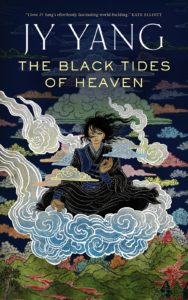 The Black Tides of Heaven (2017)
The Black Tides of Heaven (2017)
Written by: JY Yang
Genre: Fantasy/Silkpunk
Pages: 240 (Trade Paperback)
Publisher: Tor
Why I Chose It: Several reasons. First, it’s another contender for the Nebula award. Second, I’ve been admiring that glorious cover since the release of the Publisher’s Weekly review last August. Lastly, I I’m drawn to books by female authors, authors of color, and LGBTQIA authors, as well as authors based outside the U.S. One of my goals this year is to read five translated SFF works and review them here (good recommendations abound at Bogi Reads The World and We Need Diverse Books). So The Black Tides of Heaven automatically fits in my reading schema.
Premise:
The first entry in Yang’s Tensorate series set on the planet Ea follows the paths of twins Mokoya and Akeha, who were born to serve their cruel mother, the ruler of the Protectorate. Mokoya and Akeha grow apart as they age, but find they need each other more than ever to navigate and negate the roles their mother has forecast for them.
Some mild spoilers
Discussion: This could be any “two twins grow apart and take different journeys” story, but it isn’t. This could be any story about a rebellion, but it isn’t. It’s a familiar story but made unique: it’s set on a planet where people choose their gender when they reach a certain age, and where slackcraft (magic) is used to manipulate the environment–science is just being discovered. Akeha and Mokoya are adept at manipulating the Slack, but although neither trusts their mother, the Protector, neither realize until they are older that she believes Slack should be used by the privileged few. This puts her in direct opposition to the Machinists, engineers and scientists who are discovering technology–aka, ways for everyone who can’t use Slack to have access to the same results (e.g., instead of communicating telepathically via Slack, the Machinists are inventing telephones). Mokoya stays to marry a subversive priest while doing her best to hide her prophetic visions from the Protector; Akeha leaves to find his own path, falling in love with a rebel and perfecting his Slackcraft, creating bombs and other tools for the Machinist rebellion (which is led by none other than the Protector’s former concubine).
The setting is why Black Tides has been described as belonging to the silkpunk subgenre. Long story short, silkpunk is to steampunk, except where steampunk is concerned with Victorian-era technology, silkpunk relates to the inventions and history of East Asia. Author JY Yang talks more about their books here.
It’s never in doubt which side Mokoya and Akeha are on; but what’s interesting is watching them be galvanized by events in the book and in turn watching them galvanize others to action. There is no middle ground; they can’t stay blind to their mother’s cruel schemes. Yet there is plenty of tenderness; no matter how far apart Akeha and Mokoya are, emotionally or physically, this story is ultimately about their relationship and devotion to each other in a changing world.
In conclusion: The unique voice, compelling characterizations, and provocative worldbuilding in The Black Tides of Heaven make it a strong contender for the Nebula novella award. I’m already halfway into the companion book, The Red Threads of Fortune.

No Comments